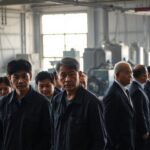Table of Contents
Introduction to the trade war’s impact on aviation
The aviation industry is feeling the heat of the ongoing trade war between the United States and China, with significant implications for major players like Boeing. Recently, a Boeing 737 MAX jet, originally destined for Xiamen Airlines, made an unexpected return to Seattle, highlighting the challenges posed by escalating tariffs.
This incident underscores the broader economic tensions that are reshaping international trade and aviation logistics.
The journey of the 737 MAX
The 737 MAX, a flagship model for Boeing, was intended for use by a Chinese airline but found itself back at Boeing Field after a lengthy journey that included refueling stops in Guam and Hawaii.
The aircraft, adorned with Xiamen Airlines’ livery, was one of several jets awaiting final touches at Boeing’s Zhoushan completion center. With a market value of approximately $55 million, the return of this aircraft raises questions about the viability of future deliveries amidst the current tariff landscape.
Understanding the tariff implications
In a dramatic escalation of trade tensions, President Trump recently increased baseline tariffs on Chinese imports to a staggering 145%. In retaliation, China imposed a 125% tariff on US goods, creating a challenging environment for companies like Boeing.
The financial burden of these tariffs could deter Chinese airlines from taking delivery of new aircraft, as the costs associated with tariffs could significantly inflate the price of each plane. This situation not only disrupts Boeing’s operations but also affects the broader aviation market, leading to uncertainty and potential delays in aircraft deliveries.
The future of Boeing and the aviation industry
The return of the 737 MAX is a stark reminder of the complexities facing the aerospace industry as it navigates the fallout from the tariff war. With many airline CEOs expressing concerns over the financial implications of these tariffs, some are considering deferring aircraft deliveries rather than incurring additional costs.
This decision could lead to a backlog of orders and further complicate Boeing’s recovery from previous challenges, including a nearly five-year import freeze on the 737 MAX. As the situation evolves, the aviation industry must adapt to the shifting landscape of international trade and tariffs, which could redefine how aircraft manufacturers operate in the future.





